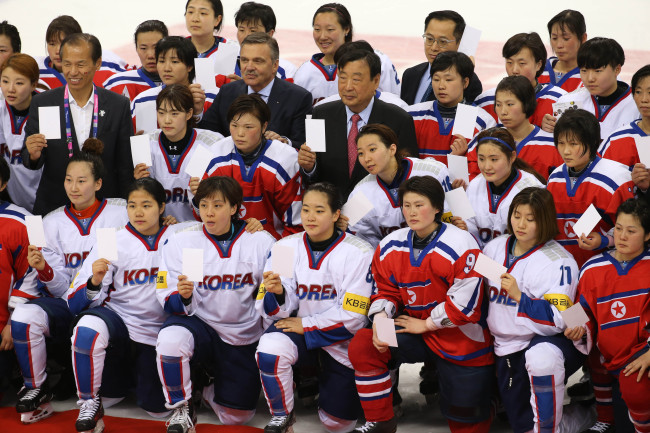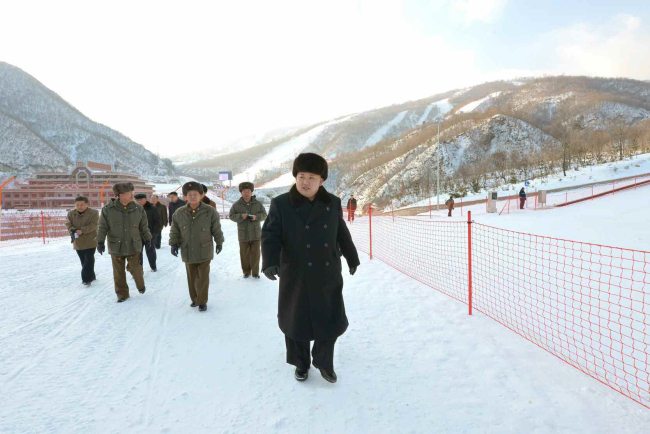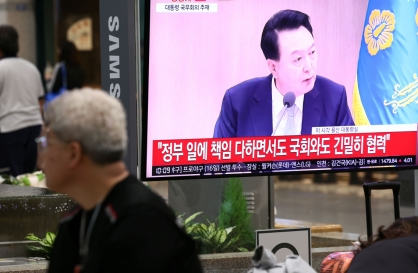Koreas to march under unification flag at Olympics
Two sides agree to form unified women’s ice hockey team; NK delegation to travel to S. Korea via western land route
By Jung Min-kyungPublished : Jan. 17, 2018 - 22:56
The two Koreas have agreed to jointly march under the “Korean Unification” flag at the opening ceremony of the PyeongChang Olympics next month, Seoul’s Unification Ministry said Wednesday, after the two Koreas sat down to discuss the North’s participation in the games.

They also agreed to form a unified women’s ice hockey team for the Olympics.
The news came as result of a vice-ministerial-level meeting at the Peace House located at the southern side of the border in the truce village of Panmunjeom. At a previous high-level meeting on Jan. 9, Pyongyang agreed to dispatch athletes, a high-level delegation, cheerleading squad, art troupe and more to the Olympics.

“The South and North will make joint entrance behind the unification flag at the opening ceremony of the PyeongChang Winter Olympics, form a unified women’s ice hockey team, and will make decisions based on cooperation between the International Olympics Committee and the respective National Olympic Committee of both nations,” a joint press statement released by the Unification Ministry on Wednesday showed.
South Korea’s Moon Jae-in administration has been hoping for the athletes of both nations to march “as one” at the opening ceremony. Seoul’s sports minister also said on Monday, if both Koreas reached a consensus on such matter they would march under the same flag.
The unification flag is a white flag with a blue shape of the Korean Peninsula in the center. North Korea designed its own flag after the 1950-1953 Korean War, while the South continues to use the Taegukgi, which was adopted before the war to represent Korea.
North Korea is forecast to dispatch a delegation of at least 400 to the Feb. 9-25 Winter Games in the South. It will include a 230-member cheering squad and a 30-member taekwondo demonstration team, according to the statement.
A joint cultural event will be held at Mount Kumgang on the North Korean east coast before the opening ceremony and a cross-border training session among ski athletes will be arranged at the slopes of Masikryong Ski Resort, which opened in late 2013, close to Wonsan, Gangwon Province.

North Korea’s delegation will use a western land route that leads to the now-shuttered joint industrial complex in the North Korean border city of Kaesong.
It will also send a 150-member delegation, including athletes to the PyeongChang Paralympics in March.
On finalizing matters linked to the North’s participation in the Winter Olympics, South Korea will further consult with the International Olympic Committee and Paralympic Committee, said the ministry. Both Koreas have reiterated that key details related to North’s participation in the Winter Games will be finalized at a meeting hosted by the IOC in Lausanne, Switzerland, Saturday.
The two Koreas have often used the cross-border land routes in the western and eastern parts of the peninsula for different purposes, including civilian exchanges. The western route links Paju, Gyeonggi Province, and the North’s Kaesong industrial park -- which was shuttered in 2016 on suspicions its revenues were being used to fund the North’s nuclear weapons program.
The North proposed the use of the route through Panmunjeom for the visit of its 140-member art troupe at separate working-level talks Tuesday. Unlike the western route, whether the Panmunjeom route will be reopened was not confirmed through the statement.
Analysts here suspect that the North has mentioned both land routes as a gesture toward the easing of tensions on the Korean Peninsula, including the restoration of the military hotline in Panmunjeom that had been shut down as inter-Korean relations deteriorated.
Wednesday's agreement offered a dramatic turnaround in long-stalled inter-Korean ties and last year's heightened tensions over the North's nuclear and missile provocations.
The Winter Paralympics are to take place from March 9-18, following the Feb. 9-25 Winter Olympics.
It would mark the first time for the North to compete in a Winter Paralympics, if the offer takes shape. A team of two North Korean athletes competed at the 2016 Rio Summer Paralympics, but never at a winter edition.
There is a high probability that North Korean skiers will compete at the Paralympics as reports of the team’s training sessions have been surfacing since last year. Ma Yoo-cheol and Kim Jung-hyun, who have registered to compete at the World Para Nordic Skiing World Cup in Oberried, Germany from Jan. 20-28, are likely candidates.
The IPC has echoed the IOC in its support of the North’s participation in the games and may grant wild-card spots to the athletes.
Wednesday’s talks were aimed at ironing out key issues, including the size of the North’s Olympic delegation, transportation, accommodations, a joint appearance at the opening ceremony and a unified women’s ice hockey team.
South Korea’s three-member delegation led by Vice Unification Minister Chun Hae-sung sat across from the North’s delegation led by Jon Jong-su, the vice chairman of the Committee for the Peaceful Reunification of the Country, a state agency in charge of inter-Korean affairs, in the meeting that kicked-off at 10 a.m.
No South Korean reporter was allowed to cover the meeting, but Kim Kang-guk, allegedly a reporter for the North’s Korean Central News Agency, attended the meeting as a delegate. Kim’s identity was largely unknown until Seoul’s Unification Ministry confirmed his position Wednesday.
The meeting was sandwiched between Tuesday’s talks on the North’s art troupe performance and Saturday’s separate gathering hosted by the IOC.
Prior to the meeting, Chun expressed hope for the PyeongChang Games to be staged peacefully and to serve as a platform for bringing lasting peace to the Korean Peninsula.
A meeting hosted by the IOC at its headquarters in Lausanne will start at 9:30 a.m. Saturday -- 5:30 p.m. Seoul time. A preparatory meeting will take place on Friday ahead of the main talks.
Whether the IPC officials will join the meeting or hold separate talks has yet to be announced.
Do Jong-hwan, culture and sports minister; Lee Hee-beom, head of PyeongChang’s Olympic organizing committee; Lee Kee-heung, president of the Korean Sport & Olympic Committee; and Ryu Seung-min, an IOC member, will represent the South in Switzerland. Kim Il-guk, North Korea’s sports minister and head of its national Olympic committee, will leave for Lausanne on Thursday. Chang Ung, the North’s IOC representative is also scheduled to head to Switzerland on the same day.
The South Korean government is carefully mapping out the North’s route to South Korea and overall plans of its stay to avoid violations of international sanctions imposed on the North Korean regime.
South Korea’s unilateral sanctions ban any vessel that has sailed to North Korea within the past 12 months from entering its waters, which rules out sea travel.
The US has also blacklisted the North’s state-run airline and several ranking individuals as well. This could cause complications with the North’s choice of figures to join the high-ranking delegation to the Olympics.
By Jung Min-kyung
(mkjung@heraldcorp.com)






![[From the Scene] Monks, Buddhists hail return of remains of Buddhas](http://res.heraldm.com/phpwas/restmb_idxmake.php?idx=644&simg=/content/image/2024/04/19/20240419050617_0.jpg&u=20240419175937)








![[From the Scene] Monks, Buddhists hail return of remains of Buddhas](http://res.heraldm.com/phpwas/restmb_idxmake.php?idx=652&simg=/content/image/2024/04/19/20240419050617_0.jpg&u=20240419175937)

![[KH Explains] Hyundai's full hybrid edge to pay off amid slow transition to pure EVs](http://res.heraldm.com/phpwas/restmb_idxmake.php?idx=652&simg=/content/image/2024/04/18/20240418050645_0.jpg&u=20240419100350)

![[Today’s K-pop] Illit drops debut single remix](http://res.heraldm.com/phpwas/restmb_idxmake.php?idx=642&simg=/content/image/2024/04/19/20240419050612_0.jpg&u=)